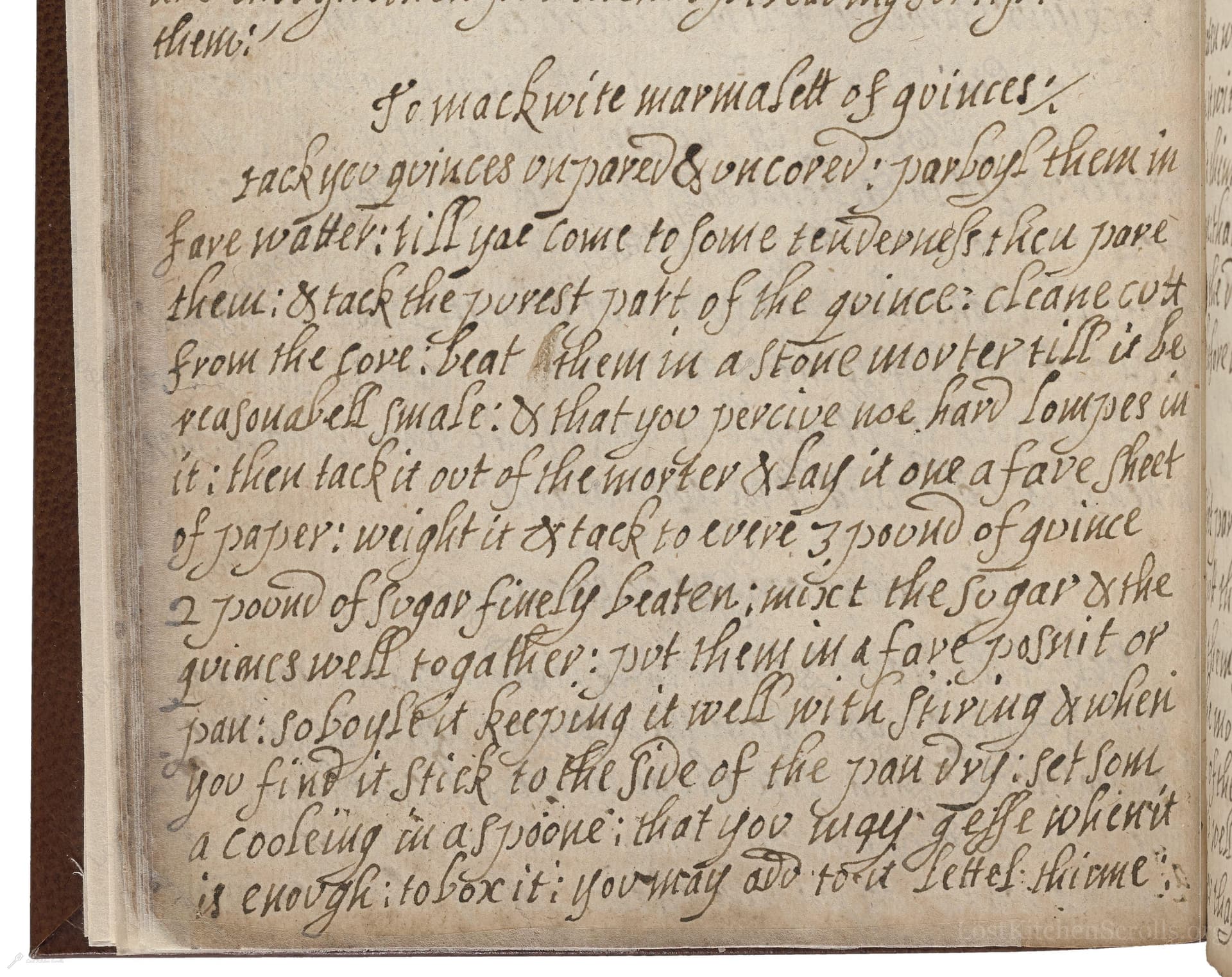To Macke Wite Marmalett Of Quinces
From the treasured pages of Cookery book of Lettice Pudsey, Seisdon, Staffordshire
Written by Lettice Pudsey

To Macke Wite Marmalett Of Quinces
"tack you quinces unpared & uncored: parboyl them in fave watter: till you come to some tendernesse then pare them: & tack the purest part of the quince: cleane cutt from the core: beat them in a stone morter till it be reasonabell smale: & that you perceive noe hard loumpes in it: then tack it out of the morter & lay it one a fave sheet of paper: weight it & tack to evere 3 pound of quince 2 pound of Sugar finely beaten: mixe the Sugar & the quinces well togather: put them in a fave posnit or pan: so boyle it keeping it well with stiring & when you find it stick to the side of the pan dry: set som a cooleing in a spoone: that you may gesse when it is enough: to box it: you may add to it littel thime:"
Note on the Original Text
The recipe is written in the direct, unpunctuated style of the late 17th century, using phonetic spelling (e.g. 'macke' for 'make', 'tack' for 'take', 'wite' for 'white', 'fave' for 'fair' or 'fine'). Measuring by weight rather than volume was standard, and the directions emphasize intuition over precision—notes like 'when you find it stick to the side of the pan dry' or 'set som a cool(e)ing in a spoone' invite the cook to use their senses. The lack of standardized spelling and punctuation reflects the era’s evolving written English.

Title
Cookery book of Lettice Pudsey, Seisdon, Staffordshire (1675)
You can also click the book image above to peruse the original tome
Writer
Lettice Pudsey
Era
1675
Publisher
Unknown
Background
Step into the 17th-century kitchen with Lettice Pudsey's delightful collection of recipes, where flavors, creativity, and tradition mingle to create a feast fit for Restoration-era tables. Expect a medley of hearty English fare, intriguing ingredient combinations, and a pinch of culinary wisdom from a bygone age.
Kindly made available by
Folger Shakespeare Library
This recipe comes from Lettice Pudsey, circa 1675, during a period when preserving fruit as pastes and marmalades was both a mark of hospitality and a means to enjoy fruits out of season. Quince was especially prized for its perfumed aroma and high pectin content, yielding beautiful jellies and preserves that graced wealthy English tables. White marmalade was the paler, less-cooked cousin to the more common red quince paste, signaling refinement and delicate handling of ingredients. The recipe reflects women’s important roles in domestic management and culinary creativity in 17th-century England, where recipes were passed down and adapted within families.

Originally, the cook would use a large cauldron or posnet (a kind of small, handled pan) for boiling, a stone mortar and pestle for pounding the fruit, and linen or paper for weighing and working the mixture. Ovens were not required—just an open fire and a good stirring spoon, likely made of wood. Marmalade would be stored in boxes of wood or ceramic jars, covered with parchment.
Prep Time
30 mins
Cook Time
1 hr
Servings
12
We've done our best to adapt this historical recipe for modern kitchens, but some details may still need refinement. We warmly welcome feedback from fellow cooks and culinary historians — your insights support the entire community!
Ingredients
- 3 lb quinces (unpeeled, uncored initially)
- 2 lb white granulated sugar
- Fresh water for parboiling
- Optional: 1–2 sprigs fresh thyme
Instructions
- To make white quince marmalade in the modern kitchen, begin by selecting fresh quinces.
- Do not peel or core them at first; simply cut them into large chunks.
- Parboil the quinces in plenty of water until they begin to soften.
- Once partially cooked, drain, peel, and core the fruit, discarding seeds and tough bits.
- Take the best, pure, unblemished portions of fruit and mash or blend them to a smooth pulp—this replaces pounding in a stone mortar.
- Weigh the quince pulp: for every 3 pounds of quince pulp, add 2 pounds of fine white sugar.
- Mix thoroughly in a heavy saucepan.
- Place the pan over low-medium heat and cook while stirring constantly to prevent sticking or burning.
- Continue until the mixture thickens and pulls away from the sides of the pan (a dab set on a spoon should hold its shape when cooled).
- If desired, add a little fresh thyme for an aromatic note.
- When done, spoon the marmalade into jars or boxes and allow to cool.
Estimated Calories
170 per serving
Cooking Estimates
Preparing quince marmalade takes about 30 minutes to cut, parboil, peel, and mash the fruit. The actual cooking on the stove takes about 1 hour. This recipe makes about 12 servings, with roughly 170 calories in each.
As noted above, we have made our best effort to translate and adapt this historical recipe for modern kitchens, taking into account ingredients nowadays, cooking techniques, measurements, and so on. However, historical recipes often contain assumptions that require interpretation.
We'd love for anyone to help improve these adaptations. Community contributions are highly welcome. If you have suggestions, corrections, or cooking tips based on your experience with this recipe, please share them below.
Join the Discussion
Rate This Recipe
Dietary Preference
Main Ingredients
Culinary Technique

Den Bockfisch In Einer Fleisch Suppen Zu Kochen
This recipe hails from a German manuscript cookbook compiled in 1696, a time whe...

Die Grieß Nudlen Zumachen
This recipe comes from a rather mysterious manuscript cookbook, penned anonymous...

Ein Boudain
This recipe comes from an anonymous German-language manuscript cookbook from 169...

Ein Gesaltzen Citroni
This recipe, dating from 1696, comes from an extensive anonymous German cookbook...
Browse our complete collection of time-honored recipes



